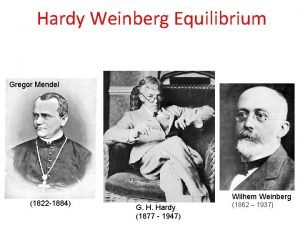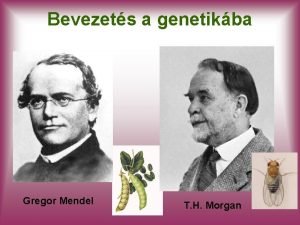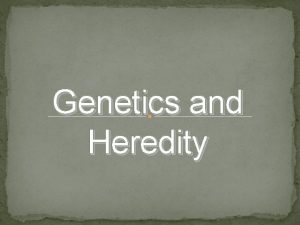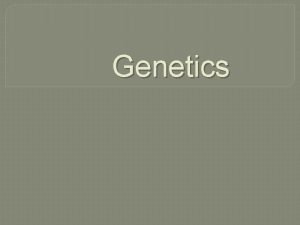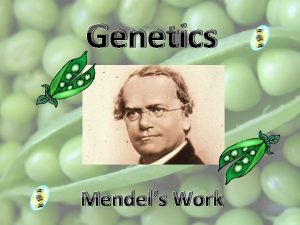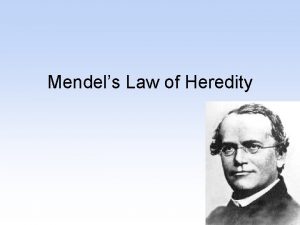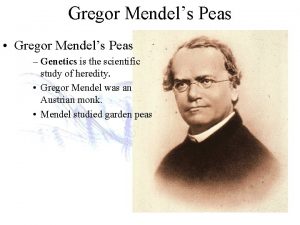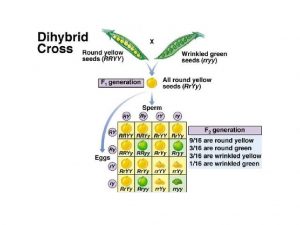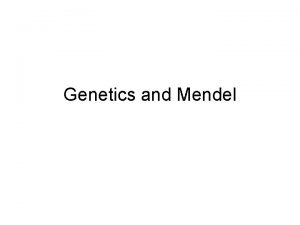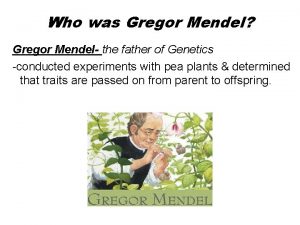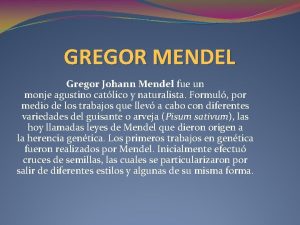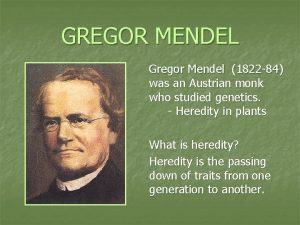Mendels Work Who was Gregor Mendel Mendel is



















- Slides: 19

Mendel’s Work

• Who was Gregor Mendel? • Mendel is the “Father of Genetics” Performed experiments with pea plants to understand the process of heredity • Heredity- Passing of physical characteristics from parents to offspring.

• Mendel wondered why different pea plants had different characteristics: • Tall • Short • Green seeds • Yellow seeds • Trait- Physical characteristics such as height or color

• Mendel observed that the pea plants traits were similar to those of their parents. • Sometimes they had different traits from those of their parents! Why? ? ? • So Mendel experimented with thousands of pea plants to understand the process of heredity (passing on of traits). • Genetics- the scientific study of heredity.

• Fertilization-the process when a new organism begins to form when a egg and sperm cell join together. • In a pea plant pollen(Male sex cells) must reach the pistil(female sex cells) of a pea flower this is called pollination. • Pea plants are usually self-pollinating. • Mendel developed a method by which he cross-pollinated pea plants: • He removed pollen from a flower on one plant then brushed the pollen onto a flower on a second plant.

• So to study different traits in pea plants mendel decided to cross plants with contrasting traits. • Example- Tall plants with short plants • Started with purebred plants. • Purebred- is the offspring of many generations that have the same trait. Ex: short pea plants always come from short parent plants.

• So in one experiment Mendel crossed purebred tall with purebred short plants. (Parent Plants or P generation) • The offspring from this cross are the first generation or F 1 (the kids) • All of the offspring in the F 1 generation were tall even though one of the parents was short none of the offspring was short! • The short trait seemed to disappear.

• Then Mendel took the plants in the F 1 generation and allowed them to self pollinate. • Surprisingly the plants in the F 2 generation were a mix of tall and short plants! • The shortness trait came back!! How was this possible when none of the F 1 parents were short? ? • In the F 2 generation About ¾ of the parents were tall and ¼ were short.

Mendel crossed other traits as well

• In all of Mendel’s crosses, only one form of the trait appeared in the new F 1 generation (All short, all Round, All Yellow seeds) • However in the F 2 generation the “lost trait always reappeared in about ¼ of the plants. • Why was this happening? ? ?

Mendel’s conclusions: • Individual factors must control the inheritance of traits • Factors that control each trait exist in pairs • The female parent contributes one factor while the male contributes one factor • One factor in a pair can hide the other (Ex: tall can hide short)

• Gene- is the word used for the factors that control a trait. • Alleles- different forms of a gene • Ex: The gene that controls height has one allele for tall and one allele for short • Each plant inherits two alleles from its parents- one from the egg other from the sperm. • A plant may inherit two alleles for tall, two alleles for short, or one of each!

• An organisms traits are controlled by the alleles it inherits from its parents! • Some alleles are dominant, while other alleles are recessive. • Dominant alleles- one whose trait always shows up when the allele is present • Recessive allele- is a trait that is hidden whenever the dominant allele is present. • A trait controlled by a recessive allele will only show up if the organism does not have the dominant allele (Short plants)

• Hybrid- Has two different alleles for a trait, the dominant allele will show. • Example- F 1 generation

• Geneticists use letters to represent alleles: • Capital letters represent dominant alleles (Tall – T) • Lowercase letter represent a recessive allele (Short- t) • Tall Plant (TT or Tt) • Short Plant (tt)

3. INHERITED TRAITS: Gregor Mendel In one of his experiments to investigate the heredity of genes, he cross pollinated a white flowered pea plant with a purple flowered pea plant. PARENTS x PURPLE 1 st EXPERIMENT WHITE OFFSPRING (1 st Generation) This resulted in all of the offspring having purple flowers.

3. INHERITED TRAITS: Gregor Mendel decided to do a second experiment. He decided to self pollinate the purple flowers that were produced from the 1 st experiment. This produced offspring that had purple and white flowers. Parent Self Pollination OFFSRPING (2 nd GENERATION)

3. INHERITED TRAITS: Gregor Mendel This shocked Mendel. How could the white flowers be produced if the parent had purple flowers? He concluded that some of the traits for flower color were hidden in the 1 st generation. The traits for white flower were masked by the purple trait. The trait of having purple petals dominated the white petals, meaning that the trait of white petals was not visible. 18

Inheritance In Pea Plants: 1 st experiment When the plants were bred together. The White flower had recessive alleles for white colored petals. Meaning that both alleles pp need to be present for it to be expressed. The Purple flower had dominant alleles. For a dominant allele to be expressed you only need to have on of the alleles present. PHENOTYPE (characteristics) Pp Pp Purple flower 19
 Who was mendal
Who was mendal What is this process called
What is this process called Gregor mendels principles of genetics apply to
Gregor mendels principles of genetics apply to Chapter 12 lesson 1 the work of gregor mendel
Chapter 12 lesson 1 the work of gregor mendel Chapter 11 the work of gregor mendel
Chapter 11 the work of gregor mendel Section 11.1 the work of gregor mendel
Section 11.1 the work of gregor mendel Chapter 12 lesson 1 the work of gregor mendel
Chapter 12 lesson 1 the work of gregor mendel Who is gregor mendel
Who is gregor mendel Five conditions for hardy weinberg
Five conditions for hardy weinberg Who is gregor mendel and what did he do?
Who is gregor mendel and what did he do? Chapter 11 biology review answers
Chapter 11 biology review answers Fr gregor mendel
Fr gregor mendel Gregor mendel video
Gregor mendel video Father of genetics
Father of genetics Tesztelő keresztezés
Tesztelő keresztezés Johann sebastian bach lebenslauf für kinder
Johann sebastian bach lebenslauf für kinder Gregor johann mendel
Gregor johann mendel Mendels theory
Mendels theory What did gregor mendel research
What did gregor mendel research What is the phenotype of a chicken with the genotype fbfw?
What is the phenotype of a chicken with the genotype fbfw?








